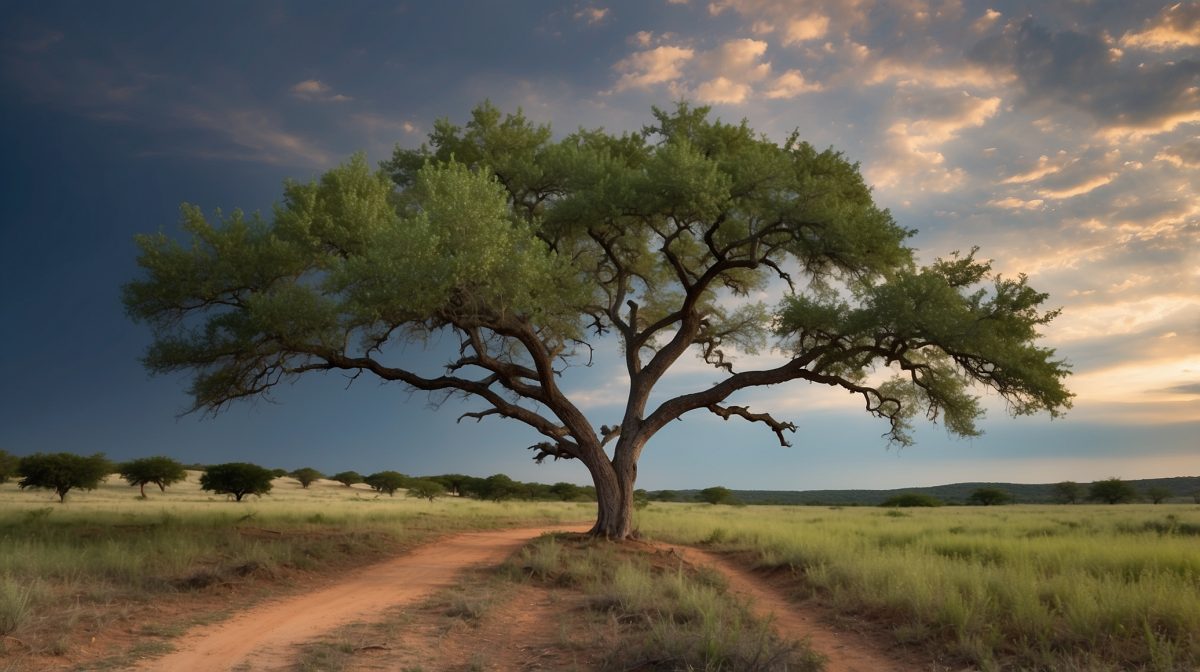From the sturdy oaks to the fragrant cedars, each tree tells a story of resilience and beauty. So, let’s mosey on through the groves and get to know some of the finest trees Texas Hill Country has to offer.
The Signature Trees of Texas Hill Country
Live Oak
Ain’t nothin’ quite as grand as the sight of a Live Oak with its sprawling branches reachin’ out like the warm embrace of an old friend. These sturdy sentinels have stood the test of time, offerin’ shade and shelter for generations. Their twisted limbs and deep roots are a testament to the enduring spirit of the Hill Country.
Live Oaks ain’t just a pretty sight; they’re a cornerstone of our heritage. From providin’ the wood for pioneer homesteads to servin’ as a gatherin’ spot for community events, these trees are woven into the fabric of our culture.
Texas Red Oak
Now, let me tell ya ’bout the Texas Red Oak – a real gem of the Hill Country. With its vibrant foliage that turns a fiery red come fall, this tree is a sight for sore eyes. Its hardy nature makes it a perfect fit for our rugged landscape, and it stands tall through drought and storm alike.
But it ain’t just about looks; the Texas Red Oak plays a crucial role in our local ecosystem. It offers a haven for wildlife and contributes to the biodiversity that makes our land so rich.
Ashe Juniper (Mountain Cedar)
Now we come to the Ashe Juniper, or as some folks like to call it, the Mountain Cedar. It’s as common as cowboy boots ’round these parts, and it sure does stir up conversation, especially when it sends out its pollen. Some folks might be sneezin’, but there’s no denyin’ its place in our landscape.
This hardy tree ain’t just about causin’ a ruckus during cedar fever season; it’s also a staple in local industry. From fence posts to furniture, the Ashe Juniper’s wood is a valuable resource for Hill Country craftspeople.
Unsung Heroes of the Hill Country Arboreal Family
Cedar Elm
Now, if you’re lookin’ for a tree that’s as tough as a two-dollar steak, set your sights on the Cedar Elm. This resilient fella can thrive just about anywhere, from creek banks to limestone outcrops. It’s the kind of tree that doesn’t fuss much about where it lays its roots.
And let’s not forget the shade it provides – a welcome respite from that Texas sun. The Cedar Elm also plays a big part in supportin’ our local critters, offerin’ food and shelter throughout the year.
Texas Madrone
The Texas Madrone is like the belle of the ball with its smooth, reddish bark and delicate white flowers. They’re a rare sight to behold, which makes ’em all the more precious to nature lovers and conservationists alike.
Findin’ one of these beauties in the wild is a special treat, and they remind us of the need to protect our natural treasures. Their appeal is undeniable, and their presence is a testament to the unique beauty of the Hill Country.
Other Notable Trees and Shrubs
Pecan Trees
When you think of Texas, you can’t help but think of pecan trees. As our state tree, they’re a proud symbol of the Lone Star State’s culture and economy. A stroll through a pecan grove is like walkin’ through a living history book, with each tree havin’ tales to tell.
And let’s talk about those delicious pecans – they’re more than just a tasty treat; they’re a boon to our economy. Pecan groves are not only scenic but also vital to our agricultural heritage.
Mountain Laurel
Come springtime, the Mountain Laurel puts on a show with its clusters of purple flowers that’ll just about knock your socks off with their sweet fragrance. This ornamental shrub is a favorite among Texans for its beauty and the splash of color it brings to the landscape.
If you’re wantin’ to catch a glimpse of these stunners in full bloom, I’ll let you in on a little secret – there are spots in the Hill Country where they’re particularly breathtaking. Trust me, it’s worth the trip.
Mesquite
The Mesquite tree is as resourceful as they come, findin’ ways to thrive in our challenging environment. It’s a true survivor, and its wood is prized for everythin’ from furniture makin’ to barbecuin’ – givin’ that meat a flavor that’s pure Texas.
But it’s not all smooth sailin’; the Mesquite’s hardiness means it can sometimes take over if we’re not careful. Balancin’ its benefits with environmental management is key to keepin’ our ecosystem healthy.
The Role of Trees in Texas Hill Country’s Ecosystem
Our native trees are more than just pretty faces; they’re the backbone of the local wildlife habitat. From the tiniest insects to the majestic white-tailed deer, these trees provide food, shelter, and a place to call home.
They’re also champions of the land, helpin’ with soil conservation and water resources. It’s a delicate dance between nature and human activity, but places like the JL Bar Ranch Resort are settin’ the standard for balancin’ conservation with ranchin’ and development.
Seasonal Changes and Where to See the Best Foliage
There’s somethin’ magical about watchin’ the seasons change through the leaves of our Hill Country trees. Whether it’s the fresh greens of spring or the rich hues of autumn, there’s always a show worth catchin’.
For those lookin’ to take in the splendor, there are spots like the JL Bar Ranch Resort that offer guided tours or self-guided trails. It’s a chance to immerse yourself in the beauty of the Hill Country and witness the seasonal transformations up close.
Conservation Efforts and How You Can Help
Conservin’ the natural beauty of Texas Hill Country is a team effort, with groups workin’ hard to protect our trees and their habitats. These folks are the unsung heroes, and they sure could use your help.
As a visitor, you can do your part by treadin’ lightly and respectin’ the land. And if you’re feelin’ inspired, why not join in on local conservation initiatives? Every little bit helps to preserve the legacy of our Hill Country trees.
Conclusion
As we wrap up our journey through the woods of Texas Hill Country, let’s take a moment to appreciate the vital role these trees play in makin’ this place so special. They’re more than just plants; they’re a living, breathin’ part of our history and culture.
For this ol’ Texas Hill Country native, there’s nothin’ quite like the connection to the land and its flora. So, here’s to the beauty and resilience of the trees that make our corner of the world truly remarkable.
FAQs
What is the most common tree found in Texas Hill Country?
The Ashe Juniper, often called Mountain Cedar, is one of the most common trees you’ll find in Texas Hill Country.
Are there any endangered tree species in the area?
Yes, the Texas Madrone is one of the rare and endangered species in the Hill Country.
Can you recommend the best time of year to see Texas Hill Country trees in bloom?
Spring is a fantastic time to see many of the Hill Country trees in full bloom, especially the Texas Mountain Laurel.
What are the biggest threats to trees in Texas Hill Country?
Urban development, overgrazing, and invasive species pose significant threats to our trees here in the Hill Country.
How can visitors to the area contribute to the conservation of local trees?
Visitors can help by respecting the natural areas, staying on trails, and supporting local conservation efforts.


